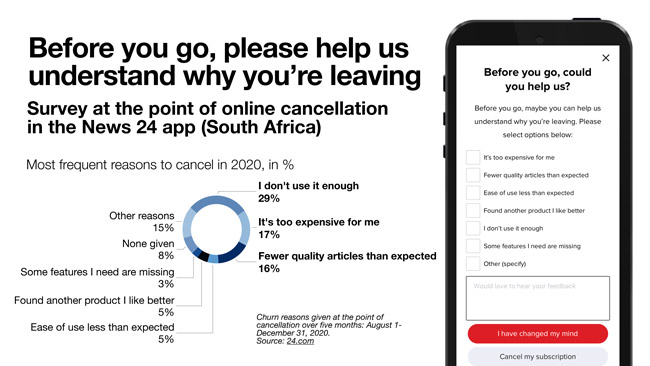How can news publishers know why a reader stops subscribing?
Readers First Initiative Blog | 28 January 2021
Every week, members reach out to INMA and me to help them find relevant research, case studies, or best practices in reader revenue.
Here is a recent question and answer.
Question: What’s a proven method for finding out why a subscriber leaves us?
Answer: Ask a reader for reasons she cancelled.
Regardless whether you require her to call to cancel, offer an online chat or simply stop a subscription on the site or an app, ask the question.
News24, a leading online news brand in South Africa, found nine in 10 people who cancelled between August and December 2020 provided the answer.
Most often they said they didn’t use the subscription enough (almost 30%), it was too expensive for them (17%), or they found fewer quality articles than expected (16%). A few percent of readers found it hard to use (5%) or they missed features they looked for (3%).
This is based on the data shared with INMA by Charlene Beukes, general manager for digital news at 24.com.
A good practice is to present a churning subscriber a cafeteria of reasons in a random order and an option to type a reason that is not on the list.

For the cafeteria, choose the reasons that suggest where the problem might be — is it an issue with engagement, pricing, payment, quality of content, or user experience?
- The aggregated answers might help you improve the produce and the offer. You can analyse them all together or by cohorts, for example, acquisition campaigns, or channels.
- Individual answers might trigger actions to save the churning subscriber, for example, readers feeling they had not enough time to read might see an option to pause the subscription.
An option to type a reason not on the list might inspire future studies. Some quotes I found in a log of churners of one leading publisher included: “Your billing periods are not flexible to meet my needs,” “Stupid moderation policy,” “App doesn’t work on my phone.”
Some publishers, such as Dennik N in Slovakia, experimented last year with asking churning subscribers about the economic hardships during the COVID-19 pandemic.
Coronavirus might have bumped sales in the spring, but the subsequent lockdowns devastated the economy. So by the fall, Dennik N found 34% of churners said they had been affected!
According to Radoslav Augustín, online product manager, the site offered them an extraordinary 50% discount “if circumstances do not allow you to pay more” or — while acknowledging their hardship — an option to still “support independent journalism” and renew the subscription at the regular price.
The empathy shown to the past subscribers had an impact — up to 30% churners renewed.
In general, we know that 67% cancellations are initiated by readers rather than payment failures. This is based on the data of 285 subscription publishers that use the paywall software of Piano, the U.S.-based vendor.
Piano Director of Research Patrick Appel shared with INMA the results of its analysis that found the tenure, price, and engagement levels with the site were most predictive for churn. In short, readers who were newly subscribed, on a free or discounted trial, and readers who visited irregularly or read just a little were found more likely to churn.
Hence, onboarding subscribers and helping them form a habit of reading is believed the single most effective tactic to get new readers through trials and keep them as subscribers.
What’s your question? E-mail me at grzegorz.piechota@inma.org































